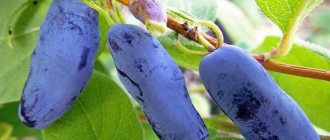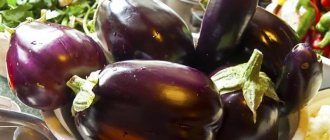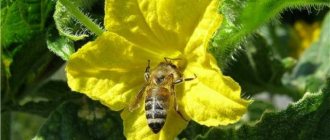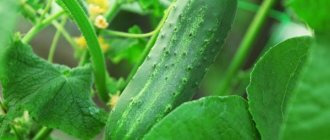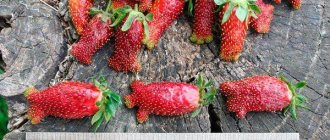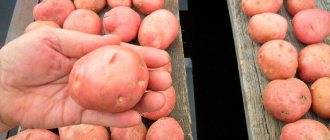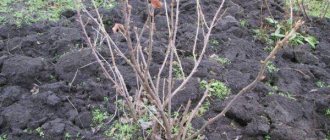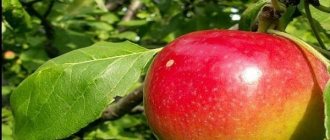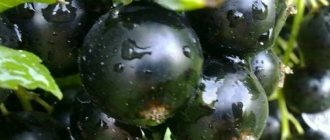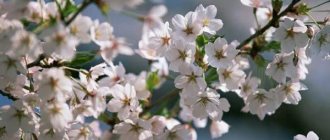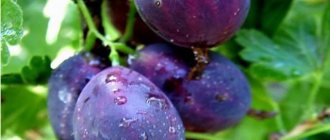Description of the variety
Honeysuckle Nymph was created by free pollination of the Leningradsky Velikan variety by the All-Russian Research Institute of Plant Growing named after. Vavilov in 1992. The State Register accepted the cultivar in 1998 after testing and recommended for cultivation in all regions.
Specifications
The Nymph variety forms a tall, slightly spreading bush with thick straight branches. The leaves are large, dark green, covered with light hard down. Young shoots are light green and slightly fleecy.
The berries of Nymph honeysuckle are medium in size - from 0.8 g to 1.1 g. They are colored blue, but due to a waxy coating they look blue. The skin of long spindle-shaped fruits is medium dense, lumpy. The maximum yield of an adult bush is 2 kg, the average is 1.3 kg. With industrial cultivation, you can collect 37 c/ha.
Tasting rating of honeysuckle Nymph - 4.7 points. The taste is sweet, with a spicy bitterness. The berries are aromatic, universally used, mid-early ripening, and fall slightly.
Pollinators
The Nymph variety is self-sterile. Any cultivars can be used as pollinators; Morena, Amphora, Viola, and Blue Spindle are good choices. There is no need to specially attract bees and bumblebees to the site - honeysuckle is a good honey plant.
Characteristic
Blue honeysuckle is a low, perennial shrub. His height is 60 cm and above. In Russia it grows in the Central part, Eastern Siberia and the Far East, and is also found in other areas. There are wild and cultivated plant species.
Many plant varieties tolerate frost easily and are unpretentious. For successful growth, regular watering and loosening of the soil under the bush is necessary. It should be noted that the root system is close to the surface of the earth.
The procedure must be carried out carefully so as not to damage it:
The berries are oblong, deep blue in color. They have a sweet and sour taste. Some species have a bitter taste. When choosing a variety, you need to know that there are edible and poisonous fruits.
Advantages and disadvantages
The variety is not the newest; it is already 20 years old. Even though the Nymph is not as large-fruited as the Giant’s Daughter, and its yield is significantly lower than that of the Bakcharsky Giant, all the qualities of this honeysuckle are time-tested. Its advantages include:
- High nutritional and medicinal value of berries.
- Possibility to grow the variety throughout Russia.
- Stability of fruiting.
- Low susceptibility of Nymphs to aphids.
- High winter hardiness.
- When ripe, the berries almost never fall off.
- Taste qualities – 4.7 points.
- Easy to care for.
- The high decorativeness of the bush allows you to use the Nymph to decorate the area.
- The productive period is up to 30 years.
Among the disadvantages of honeysuckle variety Nymph, in addition to self-sterility, are:
- Insufficient yield.
- Light weight of berries.
- Instability to re-blooming, especially in the southern regions.
But let's not forget that the variety was created at the end of the last century. The fact that it is inferior to the latest cultivars speaks not of its shortcomings, but of a high level of selection.
Advantages and disadvantages of Nymph in comparison with other varieties of honeysuckle
Despite its age (and since the appearance of Nymph honeysuckle, many new varieties have been obtained), the variety is very highly valued by specialists and amateurs. The main advantages of the Nymph include:
- stable good yield;
- highest frost resistance;
- ease of care;
- low susceptibility to pests;
- weak shattering of berries;
- versatility of crop use;
- excellent fruit taste.
The disadvantages are considered:
- short shelf life of fresh products;
- possibility of secondary flowering;
- crown thickening;
- self-sterility.
Compared to most well-known varieties, experts distinguish Nymph as a variety that bears fruit with berries of the most dessert taste. When fresh, they are considered one of the most enjoyable varieties available to gardeners. The sweet taste for honeysuckle is the exception rather than the rule: most varieties are slightly bitter, or even downright sour.
No more than a dozen varieties of honeysuckle are considered sweet. One of the best is Sibiryachka: its berries are somewhat larger, and the overall yield is slightly higher, but the word “dessert taste” is not used in relation to the berries of this variety. In addition, Siberian berries do not stick well to the bushes. The Cinderella variety is beautiful: small bushes ripen tasty berries with characteristics close to Nymph berries. Cinderella begins to bear fruit very quickly, but fruiting can stretch out to almost a month.
Honeysuckle variety Cinderella is often compared in taste to Nymph
Silginka honeysuckle is considered one of the most delicious, but the harvest has to be done only on the litter: the berries are so fragile on the bushes. Well, the honeysuckle berries of the Volshebnitsa variety have a tasting rating of 5.0, and many consider Nymph to be even a sour berry in comparison, as discussed in the next video.
Video: honeysuckle berries Nymph and Sorceress on the bushes
Thus, based on the totality of its properties, Nymph cannot be considered the best variety, and this is natural: after all, now it is already one of the oldest varieties of honeysuckle. But she does not give up her positions and enjoys well-deserved popularity.
Accommodation on site
Honeysuckle Nymph grows well throughout the Russian Federation. It can be called a variety for those who do not like surprises.
Selection of planting material
In order for honeysuckle to take root better, you need to select seedlings at the age of 2-3 years. It should have several well-developed strong branches with equal internodes. Buy container plants whenever possible. If the seedling has an open root system, pay attention to it - there should be no severe damage, black spots or signs of rot.
Comment! In lignified areas of shoots, the bark may peel off - this is a feature of the species, and not a sign of trouble.
Selecting a suitable location and preparing the soil
It is important to choose a sunny area protected from strong cold winds for planting edible honeysuckle. All kinds of depressions, lowlands or depressions are not suitable due to possible stagnation of water and accumulation of cold air.
Important! In the shade, honeysuckle bears little fruit.
The Nymph variety will grow on any soil, but will produce the best yields on loose, fertile, slightly acidic soils. Sandstones do not contribute to setting a large number of large berries. Acidic soils need liming - adding 200-400 g of fluff into the planting hole.
Honeysuckle Nymph can be planted according to the standard pattern - 1.5 m between plants, rows - at a distance of 2 m from each other. The variety looks very beautiful; the bushes can be placed around the perimeter of the site to cover less attractive low-growing crops.
Planting honeysuckle
Planting holes for honeysuckle are dug 40x40x40 cm in size. Then a bucket of humus or compost is mixed with the top fertile layer of soil, phosphorus and potassium fertilizers (50 g each). Then:
- Fill the planting hole with water.
- When it is absorbed, pour a slide of the nutrient mixture in the middle.
- A seedling is placed on top.
- The roots are straightened around the mound.
- Fill the hole with soil so as to deepen the neck by 5 cm.
- Carefully compact the earth.
- Water the honeysuckle, spending at least 10 liters of water per bush.
- Mulch the tree trunk circle with peat, humus or dry soil.
Important! The Nymph variety is best planted in autumn or late summer. Then the survival rate of honeysuckle will be 95-97%. When planting in spring, this figure drops to 82-85%.
Landing Features
The development and productivity of berry bushes largely depends on the right location and the health of the seedlings.
Selecting a location
Honeysuckle is a winter-hardy crop and is not afraid of cold winds, so it can be planted in an open area, but on the condition that most of the day it will be well lit and warmed by the sun. The nymph will grow in the shade, but the lack of light will negatively affect the yield and taste of the berries.
Honeysuckle should be planted in well-lit places.
The variety is unpretentious to soil conditions, but still prefers loamy, organic soils with neutral acidity. On acidic soils, the shrub slowly dies. The crop should not be planted in low-lying damp places with close groundwater: excess moisture leads to rotting of the roots.
Landing dates
The best time to plant seedlings on a plot is from August to the end of October. Spring planting is undesirable, since honeysuckle begins the growing season very early. In mid-March, the buds swell, and transplanting at this time will have a negative impact on the plant: it begins to hurt and does not take root well.
Only in certain areas, in the absence of snow in the spring (until March 15), can berry bushes be planted using the transshipment method.
Selection of seedlings
Garden centers now offer a large assortment of cultivated honeysuckle. There you can choose exactly those varieties that are zoned to local conditions, and receive qualified advice on growing crops. Nurseries usually sell seedlings in containers - planted with a clod of soil, they quickly and painlessly take root. It is best to purchase 2-3 year old plants.
It is better to purchase honeysuckle seedlings with a closed root system - they will take root painlessly and begin to grow.
Healthy seedlings should have flexible branches with buds, a developed root system, without signs of rot. When choosing plants, gardeners are often confused by peeling bark. However, this feature of this berry crop has nothing to do with the low quality of the seedling.
Landing rules
The site is prepared 2–3 weeks before planting. They dig up the ground, remove weeds, dig holes 40 cm wide and deep. A drainage layer of pebbles or expanded clay is placed at the bottom, and part of the fertile soil mixed with 20 liters of humus, 60 g of superphosphate and 500 g of ash is poured on top (instead of ash, you can add 500 g chalk).
An hour before planting, the seedling is dipped into a solution with Kornevin, which stimulates root formation.
- A mound of fertile soil is formed in the center of the pit.
- Place the seedling, straightening the roots well. Plants from the container are planted with soil.
For a honeysuckle seedling you need to dig a hole 40 cm deep
After planting, the soil is compacted so that there are no voids left.
It is recommended not to prune honeysuckle seedlings immediately after planting - shortening the shoots leads to delayed fruiting.
Growing honeysuckle
Honeysuckle is easy to care for, it is not capricious and rarely gets sick. The main thing is to choose the right place and plant the plant.
Caring for a young plant
Only young honeysuckle requires close attention in the year of planting. It needs to be watered regularly so that the root does not dry out. When the top layer of soil dries a little, the soil is loosened to a depth of 5-8 cm. Weeds are removed from the tree trunk circle.
If fertilizers have been added to the planting hole, the first 2 years are limited to spring nitrogen fertilizing. It is better to do it on snow that has not yet melted - add ammonium nitrate or urea to a bucket of water according to the instructions and water the honeysuckle.
Caring for an adult plant
Adult bushes are watered as needed, the soil is loosened and weeds are pulled out. The tree trunk circle is mulched with organic matter. The annual spring feeding after fruiting of honeysuckle is given a full mineral complex, and in early autumn - phosphorus-potassium fertilizers.
Important! Try to carry out all work carefully - fragile branches are easy to break.
Pruning and wintering
Regular pruning of young honeysuckle is not necessary. How and when to delete branches is indicated in the table.
| Age | Trimming type | Trimming method | Target |
| up to 15 years | Sanitary | Remove all broken, dry shoots that thicken the crown and lying on the ground | Prevent the development of diseases, increase the yield of the bush |
| 15-20 years | Thinning | The oldest skeletal branches are gradually cut out | Removing unproductive shoots |
| 20 years | Rejuvenating | The bush is cut completely at a height of 15-20 cm | Extend the fruiting of honeysuckle for 5-10 years |
There is no need to cover the Nymph variety for the winter - it will withstand the harshest winter perfectly.
Caring for an adult plant
There are three main points that you should not forget about when caring: lighting, watering and pruning.
The bush should have bright lighting, so do not plant it in the shade of large trees, a fence or a house.
Honeysuckle Nymph loves generous watering. The bush needs the most water during the formation of ovaries (the better you water the Nymph, the less bitter its berries will be).
The bush needs rejuvenating pruning (it is carried out in early spring, shoots that extend deep into the bush, as well as lateral ones that do not bear fruit) are cut under the knife, as well as sanitary (dry, diseased, broken branches are removed).
In addition, honeysuckle can be fed several times a year. At the beginning of spring, water the Nymph with a solution of fermented chicken droppings or manure. Towards the end of spring (ovaries forming), add wood ash (a glass under the bush) and/or potassium complex.
You can also carry out preventive spraying against diseases: in the spring the bushes are treated with Bordeaux mixture. During the same period, you need to have time to treat plants infected with mites or aphids. When the berries are formed, it will no longer be possible to treat the bushes with insecticides.
This table will tell you about the Nymph diseases that you may encounter, as well as their treatment:
Harvesting
The first fruits grow on the bush a year after planting (if the seedling was two years old).
In central Russia, you can enjoy honeysuckle from the end of May. That is, even earlier than strawberries, and even more so raspberries. But the bulk of the berries on the bush fully ripen in mid-June. In short, this variety is relatively mid-season.
Electric Spray Gun || Electric spray gun for home
An adult bush can produce from 1.5 to 2 kg per year
You can store honeysuckle in the freezer to later use it as a filling for pies or adding to a cottage cheese casserole. Also, jam is made from the berries for the winter, compotes and even juices are prepared (though not without adding water), and marshmallows are made. The berries can also be dried whole.
Preparing for winter
In forests, honeysuckle can be seen in northern regions, such as Altai, the Urals, Siberia (for my Ukrainian aunt, who lives in the relatively warm Kiev region, this is a real curiosity). So it is not surprising that the plant is winter-hardy.
There is no need to insulate it.
However, when preparing the Nymph for frost, you can water it thoroughly, and then mulch the tree trunk circle with humus.
If the winter turns out to be particularly harsh, the tips of the branches of the bush will freeze. By spring they will dry out. Cut off such shoots, and the bush will grow new, healthy ones.
Reproduction methods
Fresh honeysuckle seeds have good germination, but seedlings do not inherit varietal characteristics. This method of propagation is interesting for breeders, but amateur gardeners simply do not need it. It is difficult to root green and lignified cuttings on your own - no more than 20-30% of seedlings will survive, and only when using greenhouses, greenhouses, growth and rooting hormones.
In private farms, honeysuckle is propagated by dividing young bushes and layering.
Reviews
- Anastasia: “I tried honeysuckle for the first time only a couple of years ago, it has a very unusual taste, I don’t even know what it can be compared with. At the dacha we planted several varieties together, one of which was “Nymph”. All the seedlings took root surprisingly quickly, fruiting is always very active. I won’t say that the bushes are strewn with berries, but for the needs of a small family, three bushes are more than enough. The berries make very tasty jam, as well as compotes. Children don’t always eat this delicacy, but I really like the taste of fresh berries.”
- Vladimir: “I remember the taste of honeysuckle from childhood, so I was happy to plant the “Nymphs” bush at the dacha. Then, however, I had to buy another one, because I read information about the self-fertility of the variety. The harvest is consistently small, but the size of the bush is not exactly gigantic. I really like the unusual shape of the berries, as well as the pleasant taste. Forest honeysuckle has a more pronounced bitterness, so garden varieties are more attractive in this regard. I haven’t noticed any particular difficulties in caring for it; I water and feed it along with other trees and shrubs.”
Problems during cultivation
Honeysuckle Nymph is rarely affected by aphids. When attacked by scale insects or leaf roller caterpillars, you need to use insecticides or biological preparations, such as Agrovertin, Iskra-bio, Fitoverm.
Among the diseases, you should pay attention to powdery mildew. This fungus appears on honeysuckle in cold rainy weather or during evening overhead watering. It needs to be combated with fungicides, and if the disease appears during the ripening of the berries, with the biological preparation Fitosporin or folk remedies.
Agricultural technology
Growing the crop in question is not at all difficult. The main thing is to choose the right place for it on the site and follow the basic rules of agricultural technology.
Selecting a location
First of all, the gardener must decide on a place to grow the crop. It is worth considering that the vegetation is perennial, and plantings will occupy a specific area for at least 30 years. For full development and fruiting, honeysuckle needs good lighting (planting in partial shade is allowed). Groundwater should be located at least 1.5 m. There are no special requirements regarding soil quality, but vegetation develops better on well-aerated, light and medium-density soils.
Soil preparation is carried out six months before planting. At this stage, it is dug up to a depth of 40 cm, then treated with a 3% solution of copper sulfate at the rate of 1 liter of liquid per 10 m². A week later, for repeated digging to a depth of 20 cm, 10 kg of sand, 10 kg of peat, 20 kg of manure are added per square meter. A week before planting, the soil must be dug up again to a depth of 20 cm.
Planting and care
It is best to plant honeysuckle from mid-September to mid-October. The planting scheme involves placing bushes at a distance of 2 m from each other and a step between rows of 3 m. It is better to alternate plants in a row, that is, plant a Nymph seedling, and after 2 m - a pollinator variety.
Step by step planting process:
- Dig a hole 40 cm deep.
- Pour 5 liters of water into it.
- Mix the soil from the pit with 10 kg of compost and 10 kg of sand.
- Fill the hole one-third full with soil.
- Form a mound in the center of the hole.
- Powder the roots of the seedling with wood ash.
- Place the seedling in the hole, level it so that the root collar is flush with the soil after it is filled.
- Fill the hole with soil, compact the tree trunk circle, and fill it with 5 liters of water.
- After absorbing moisture, mulch the tree trunk circle with a layer of compost.
The frequency of irrigation depends on climatic conditions. In areas with a temperate climate and sufficient precipitation, moistening can be carried out only 4 times a season; when a dry period occurs, the frequency of watering increases, as does the amount of liquid applied to one plant (12 liters of water per bush). In the southern regions, watering should be carried out weekly at 8–10 liters per square meter of soil.
Fertilizing begins from the 3rd year of plant life on the site. Once a season, in the spring, before the buds swell, add 1 bucket of compost diluted with water (1:1) to each bush. The next year, after the first feeding, instead of organic matter, 20 g of potassium salt, 50 g of sodium nitrate, 40 g of superphosphate are used for each bush. The addition of organic matter and mineral components is alternated annually. Throughout the season, during watering, 300 g of wood ash per bush can be added to the water for irrigation 1 or 2 times.
After precipitation and scheduled watering, it is necessary to mulch the soil. This can be done using compost, freshly cut grass or gravel. Such an event is necessary to maintain optimal moisture in the soil and prevent the growth of weeds. Loosening should be done as rarely as possible, since plant roots are located in the upper layers of the soil. The depth of penetration into the soil when weeding should not exceed 7 cm.
Features of pollination
If a pollinating variety is not planted next to the Nympha shrubs, you may not expect a good harvest. It belongs to the self-sterile varieties. The best varieties for cross-pollination are Leningradsky giant and Kamchatskaya honeysuckle.
Disease and pest control
During the existence of the variety, there was no information about disease infection. For preventive purposes, spraying is not carried out on this plant. Occasionally, bushes may be attacked by pests such as aphids and leaf rollers. If these parasites appear, the plantings are treated with Fitoverm according to the instructions on the packaging or dusted on the leaves and soil with wood ash.
Pruning and crown formation
Honeysuckle requires only sanitary pruning; crown formation is not carried out for this type of plant. They begin to implement them from the third year after planting, in the fall. First of all, remove branches that grow in close proximity to the soil, then those that thicken the crown and those that are broken. Once every 10 years, anti-aging pruning is carried out, removing branches that do not bear fruit.
Wintering
There is no need to cover the bushes of the variety in question for the winter. But you should definitely carry out pre-winter preparation, which consists of the following:
- moisture-charging irrigation, 20 liters of water per square meter, in mid-September - early October;
- mulching the soil with compost to a height of 5 cm.
The most important thing in a few sentences
- Honeysuckle Nymph is a plant that you rarely see. Many people are afraid of this berry, believing that it is bitter (like forest berries). But this is not so, varietal honeysuckle has a pleasant taste.
- This plant should be planted in late summer or early autumn. Choose a two-year-old seedling - it takes root better. The main thing is to choose a sunny, cozy corner on the site for the Nymph.
- This variety requires a pollinator, so immediately buy at least one more cultivated honeysuckle variety to pair with Nymph.
- Shrub care is basic: frequent watering, spring pruning, several feedings per season.
But this is not the only worthy variety of edible honeysuckle. From this video you will learn about other plants from the new generation - and this will not be dry information, but a visual demonstration of the branches and fruits of each variety:
